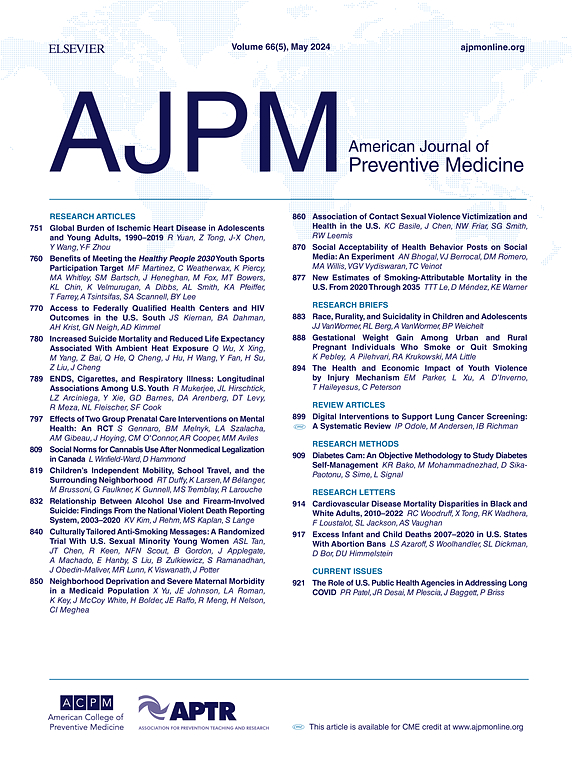Spouses’ Individual and Shared Cumulative Risk: Implications for Functional Health and Longevity in Older Adulthood
IF 4.3
2区 医学
Q1 MEDICINE, GENERAL & INTERNAL
引用次数: 0
Abstract
Introduction
Multisystem biological risk, a marker of physiological dysregulation, accumulates over time in response to exposure and adaptation to chronic stress. Spousal concordance in health and health behaviors indicates potential for shared risk to accumulate within couples. This study examined spouses’ shared multisystem biological risk as a modifier of individual risk and predictor of future functional limitations and mortality.
Methods
Biomarkers and physical measures from 3,856 heterosexual couples (77%White, 31% college degree) were collected from the 2008/2010 waves of the Health and Retirement Study to construct individual and shared frailty, cardiometabolic, and total risk indices and predict functional limitations and survival at 2016/2018.
Results
Multilevel Poisson and logistic regressions showed couples’ cumulative shared frailty, cardiometabolic, and total risk to be associated with the number of functional limitations and survival status at follow-up. Spouses’ shared cardiometabolic and total risks attenuated the effects of respective individual risks. Results were partially explained by partner selection and health experiences. Predicted probabilities were compared to gender-stratified models. The Receiver Operating Characteristic curve showed models of shared risk to have greater predictive power.
Conclusions
The findings from this study indicate that the cost of adaptation manifests not only in individuals, but also through an additional pathway that is co-constructed and shared by spouses. These findings underscore the critical role of shared context between individuals and their spouses in the treatment process.
配偶的个人和共同累积风险:对老年人功能健康和寿命的影响。
多系统生物风险是生理失调的标志,随着时间的推移,随着暴露和适应慢性应激而积累。配偶在健康和健康行为方面的一致性表明,夫妻之间存在共同风险积累的可能性。本研究考察了配偶共同的多系统生物风险作为个体风险的修饰因子和未来功能限制和死亡率的预测因子。方法:从2008/2010年健康与退休研究中收集3856对异性恋夫妇(77%为白人,31%为大学学历)的生物标志物和生理指标,构建个体和共同的虚弱、心脏代谢和总风险指标,并预测2016/2018年的功能限制和生存。结果:多水平泊松和logistic回归显示,夫妻的累积共同虚弱、心脏代谢和总风险与随访时功能限制的数量和生存状态有关。配偶共同的心脏代谢和总风险减弱了各自个体风险的影响。结果部分解释了伴侣选择和健康经历。预测的概率与性别分层模型进行了比较。受试者工作特征曲线显示共担风险的模型具有更强的预测能力。结论:本研究结果表明,适应成本不仅体现在个体身上,还体现在配偶共同构建和共享的额外途径上。我们的发现强调了在治疗过程中个人和配偶之间共享环境的关键作用。
本文章由计算机程序翻译,如有差异,请以英文原文为准。
求助全文
约1分钟内获得全文
求助全文
来源期刊

American Journal of Preventive Medicine
医学-公共卫生、环境卫生与职业卫生
CiteScore
8.60
自引率
1.80%
发文量
395
审稿时长
32 days
期刊介绍:
The American Journal of Preventive Medicine is the official journal of the American College of Preventive Medicine and the Association for Prevention Teaching and Research. It publishes articles in the areas of prevention research, teaching, practice and policy. Original research is published on interventions aimed at the prevention of chronic and acute disease and the promotion of individual and community health.
Of particular emphasis are papers that address the primary and secondary prevention of important clinical, behavioral and public health issues such as injury and violence, infectious disease, women''s health, smoking, sedentary behaviors and physical activity, nutrition, diabetes, obesity, and substance use disorders. Papers also address educational initiatives aimed at improving the ability of health professionals to provide effective clinical prevention and public health services. Papers on health services research pertinent to prevention and public health are also published. The journal also publishes official policy statements from the two co-sponsoring organizations, review articles, media reviews, and editorials. Finally, the journal periodically publishes supplements and special theme issues devoted to areas of current interest to the prevention community.
 求助内容:
求助内容: 应助结果提醒方式:
应助结果提醒方式:


